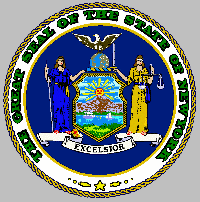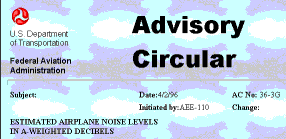

===================================================================
Aviation Conspiracy Newsletter #33.........................................................October 17, 1999 ===================================================================
Is It Time For INTERNATIONAL Noise Pollution Standards?
 A
International Noise Standard Analysis Needed? As
the Clinton/Gore administration is trying to get international
noise standards for aircraft, so the European Union will accept
noisy, U.S., "hushkitted," stage 3 aircraft, shouldn't
there be an agreement on a common noise ANALYSIS standard also?
Or do they WANT different confusing noise analysis? While the
Aviation Cabal has been extremely successful in quashing studies
by getting their U.S. Congressional bribe recipients to stop the
funding for these projects, they have had less success in Europe
and with the U.N.'s World Health Organization (WHO). WHO has
actually done a study in 1995 on the health impacts of noise.
(read abstract of report below or go to website: http://www.who.int/environmental_information/Information_resources/community_noise.htm
or download and view the entire report from website: http://www.who.int/environmental_information/Information_resources/documents/Noise/noise1.pdf
This is a pdf file that you need an Acrobat Reader to view.
Unfortunately, they use a different way of analyzing (LAeq
instead of DNL) noise than the FAA does.
A
International Noise Standard Analysis Needed? As
the Clinton/Gore administration is trying to get international
noise standards for aircraft, so the European Union will accept
noisy, U.S., "hushkitted," stage 3 aircraft, shouldn't
there be an agreement on a common noise ANALYSIS standard also?
Or do they WANT different confusing noise analysis? While the
Aviation Cabal has been extremely successful in quashing studies
by getting their U.S. Congressional bribe recipients to stop the
funding for these projects, they have had less success in Europe
and with the U.N.'s World Health Organization (WHO). WHO has
actually done a study in 1995 on the health impacts of noise.
(read abstract of report below or go to website: http://www.who.int/environmental_information/Information_resources/community_noise.htm
or download and view the entire report from website: http://www.who.int/environmental_information/Information_resources/documents/Noise/noise1.pdf
This is a pdf file that you need an Acrobat Reader to view.
Unfortunately, they use a different way of analyzing (LAeq
instead of DNL) noise than the FAA does.
 New York State's Airport
"Bubble Bill" Stagnates In Committee: As the Federal Government and the EPA
refuse to monitor the air pollution impacts of highly polluting
airports, some states, like New York, have had efforts by some
politicians to do analysis on a the state level. The "Bubble
Bill" (see website: http://pages.prodigy.net/rockaway/bubblebill.htm ) is such an effort. Unfortunately,
local politicians, like the "best Congress (aviation) money
can buy," afraid that this might affect airport
expansion, refuse to allow even ANALYSIS
of airport impacts. A story (see website: http://www.nypost.com/101299/news/15697.htm ) in the New York Post this week shows
N.Y. City's air is 100 TIMES cancer-risk level
targeted by 1990's Clean Air Act. But what do politicians care.
New York State's Airport
"Bubble Bill" Stagnates In Committee: As the Federal Government and the EPA
refuse to monitor the air pollution impacts of highly polluting
airports, some states, like New York, have had efforts by some
politicians to do analysis on a the state level. The "Bubble
Bill" (see website: http://pages.prodigy.net/rockaway/bubblebill.htm ) is such an effort. Unfortunately,
local politicians, like the "best Congress (aviation) money
can buy," afraid that this might affect airport
expansion, refuse to allow even ANALYSIS
of airport impacts. A story (see website: http://www.nypost.com/101299/news/15697.htm ) in the New York Post this week shows
N.Y. City's air is 100 TIMES cancer-risk level
targeted by 1990's Clean Air Act. But what do politicians care.
 FAA's List Of Noisiest Planes:
Most anti-aviation activists would probably disagree with the way
the aviation industry-bribed government does analysis of noise
impacts. However, the FAA list "ESTIMATED AIRPLANE NOISE
LEVELS" (from worse to least) is interesting and seems
accurate. I can personally attest to the accuracy of the Concorde
topping the list as the worse noise polluting plane and the
Boeing 747 being a close second. Check out the FAA's own listing
of noisy planes at the websites: http://www.aee.faa.gov/aee-100/aee-110/AC36-3GT/AC36-3GT.htm
http://www.aee.faa.gov/aee-100/aee-110/AC36-3GT/a1tview.htm
http://www.aee.faa.gov/aee-100/aee-110/AC36-3GT/App1app.htm
FAA's List Of Noisiest Planes:
Most anti-aviation activists would probably disagree with the way
the aviation industry-bribed government does analysis of noise
impacts. However, the FAA list "ESTIMATED AIRPLANE NOISE
LEVELS" (from worse to least) is interesting and seems
accurate. I can personally attest to the accuracy of the Concorde
topping the list as the worse noise polluting plane and the
Boeing 747 being a close second. Check out the FAA's own listing
of noisy planes at the websites: http://www.aee.faa.gov/aee-100/aee-110/AC36-3GT/AC36-3GT.htm
http://www.aee.faa.gov/aee-100/aee-110/AC36-3GT/a1tview.htm
http://www.aee.faa.gov/aee-100/aee-110/AC36-3GT/App1app.htm
&&&&&&&&&&&&&&&&&&&&&&&&&&&&&&&&&&&&&&&&&&&&&&&&&&
Aviation News Stories
Community
noise
edited by Birgitta Berglund and Thomas
Lindvall.
Document prepared for WHO.
Archives of the Centre for Sensory
Research, Vol. 2, Issue 1, 1995.
Stockholm University and Karolinska
Institute.
Abstract:
The document critically reviews the adverse effects of community
noise, including interference with communication, noise-induced
hearing loss, annoyance responses, and effects on sleep, the
cardiovascular and psychophysiological systems, performance,
productivity, and social behavior. Noise measures or indices
based only on energy summation are not enough for the
characterization of most noise environments. This is particularly
true when concerned with health assessment and predictions. It is
equally important to measure and display the maximum values of
the noise fluctuations, preferably combined with a measure of the
number of noise events, and to assess whether the noise includes
a large proportion of low frequency components.
For dwellings, recommended guideline values inside bedrooms are
30 dB LAeq for steady-state continuous noise and for a noise
event 45 dB LAmax. To protect the majority of people from being
seriously annoyed during the daytime, the sound pressure level
from steady, continuous noise on balconies, terraces, and in
outdoor living areas should not exceed 55 dB LAeq. To protect the
majority of people from being moderately annoyed during the
daytime, the sound pressure level should not exceed 50 dB LAeq.
At nighttime outdoors, sound pressure levels should not exceed 45
dB LAeq, so that people may sleep with bedroom windows open.
In schools and preschools, to be able to hear and understand
spoken messages in class rooms, the sound pressure level should
not exceed 35 dB LAeq during teaching sessions. For hearing
impaired children, a still lower level may be needed. The
reverberation time in the class room should be about 0.6 s, and
preferably lower for hearing impaired children. For assembly
halls and cafeterias in school buildings, the reverberation time
should be less than 1 s. For outdoor playgrounds the sound
pressure level from external sources should not exceed 55 dB
LAeq.
In hospitals during nighttime, the recommended guideline values
for wardrooms should be 30dB LAeq together with 40 dB LAmax.
Since patients have less ability to cope with stress, the
equivalent soundpressure level should not exceed 35 dB LAeq in
most rooms in which patients are being treated, observed or
resting.
The concern for protecting young people's hearing during leisure
time activities warrants provisional guidelines for concert
halls, outdoor concerts and discotheques. It is recommended that
patrons should not be exposed to sound pressure levels greater
than 100 dB LAeq during a 4-hour period. The same guideline
values apply for sounds played back in headphones when converted
to equivalent free-field level. To avoid hearing deficits from
toys and fireworks, performers and audience should not be exposed
to more than 140 dB(peak) of impulsive sounds. Existing large,
quiet outdoor areas in parkland and conservation areas should be
preserved and the background-to-noise ratio be kept low.
This page is maintained by
The Rivermouth Action Group Inc
as a community service.